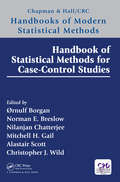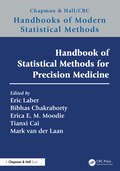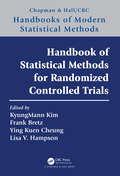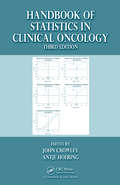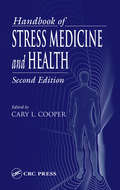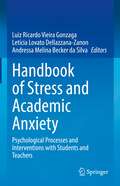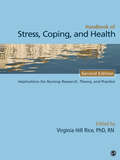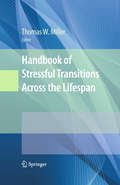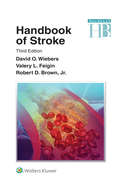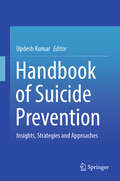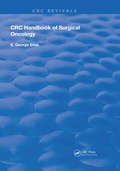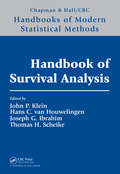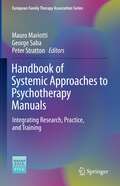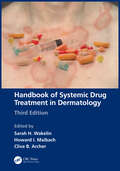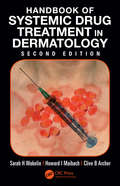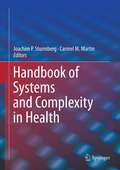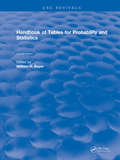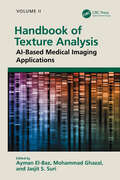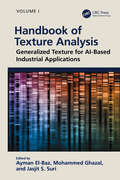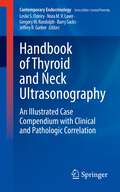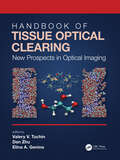- Table View
- List View
Handbook of Statistical Methods for Case-Control Studies (Chapman & Hall/CRC Handbooks of Modern Statistical Methods)
by Nilanjan Chatterjee Mitchell H. Gail Ørnulf Borgan Norman Breslow Alastair Scott Chris J. WildHandbook of Statistical Methods for Case-Control Studies is written by leading researchers in the field. It provides an in-depth treatment of up-to-date and currently developing statistical methods for the design and analysis of case-control studies, as well as a review of classical principles and methods. The handbook is designed to serve as a reference text for biostatisticians and quantitatively-oriented epidemiologists who are working on the design and analysis of case-control studies or on related statistical methods research. Though not specifically intended as a textbook, it may also be used as a backup reference text for graduate level courses. Book Sections Classical designs and causal inference, measurement error, power, and small-sample inference Designs that use full-cohort information Time-to-event data Genetic epidemiology About the Editors Ørnulf Borgan is Professor of Statistics, University of Oslo. His book with Andersen, Gill and Keiding on counting processes in survival analysis is a world classic. Norman E. Breslow was, at the time of his death, Professor Emeritus in Biostatistics, University of Washington. For decades, his book with Nick Day has been the authoritative text on case-control methodology. Nilanjan Chatterjee is Bloomberg Distinguished Professor, Johns Hopkins University. He leads a broad research program in statistical methods for modern large scale biomedical studies. Mitchell H. Gail is a Senior Investigator at the National Cancer Institute. His research includes modeling absolute risk of disease, intervention trials, and statistical methods for epidemiology. Alastair Scott was, at the time of his death, Professor Emeritus of Statistics, University of Auckland. He was a major contributor to using survey sampling methods for analyzing case-control data. Chris J. Wild is Professor of Statistics, University of Auckland. His research includes nonlinear regression and methods for fitting models to response-selective data.
Handbook of Statistical Methods for Precision Medicine (ISSN)
by Bibhas Chakraborty Tianxi Cai Eric Laber Moodie, Erica E. M. van der Laan, MarkThe statistical study and development of analytic methodology for individualization of treatments is no longer in its infancy. Many methods of study design, estimation, and inference exist, and the tools available to the analyst are ever growing. This handbook introduces the foundations of modern statistical approaches to precision medicine, bridging key ideas to active lines of current research in precision medicine.The contributions in this handbook vary in their level of assumed statistical knowledge; all contributions are accessible to a wide readership of statisticians and computer scientists including graduate students and new researchers in the area. Many contributions, particularly those that are more comprehensive reviews, are suitable for epidemiologists and clinical researchers with some statistical training. The handbook is split into three sections: Study Design for Precision Medicine, Estimation of Optimal Treatment Strategies, and Precision Medicine in High Dimensions.The first focuses on designed experiments, in many instances, building and extending on the notion of sequential multiple assignment randomized trials. Dose finding and simulation-based designs using agent-based modelling are also featured. The second section contains both introductory contributions and more advanced methods, suitable for estimating optimal adaptive treatment strategies from a variety of data sources including non-experimental (observational) studies. The final section turns to estimation in the many-covariate setting, providing approaches suitable to the challenges posed by electronic health records, wearable devices, or any other settings where the number of possible variables (whether confounders, tailoring variables, or other) is high. Together, these three sections bring together some of the foremost leaders in the field of precision medicine, offering new insights and ideas as this field moves towards its third decade.
Handbook of Statistical Methods for Randomized Controlled Trials (Chapman & Hall/CRC Handbooks of Modern Statistical Methods)
by Frank Bretz KyungMann Kim Ying Kuen K. Cheung Lisa V. HampsonStatistical concepts provide scientific framework in experimental studies, including randomized controlled trials. In order to design, monitor, analyze and draw conclusions scientifically from such clinical trials, clinical investigators and statisticians should have a firm grasp of the requisite statistical concepts. The Handbook of Statistical Methods for Randomized Controlled Trials presents these statistical concepts in a logical sequence from beginning to end and can be used as a textbook in a course or as a reference on statistical methods for randomized controlled trials. Part I provides a brief historical background on modern randomized controlled trials and introduces statistical concepts central to planning, monitoring and analysis of randomized controlled trials. Part II describes statistical methods for analysis of different types of outcomes and the associated statistical distributions used in testing the statistical hypotheses regarding the clinical questions. Part III describes some of the most used experimental designs for randomized controlled trials including the sample size estimation necessary in planning. Part IV describe statistical methods used in interim analysis for monitoring of efficacy and safety data. Part V describe important issues in statistical analyses such as multiple testing, subgroup analysis, competing risks and joint models for longitudinal markers and clinical outcomes. Part VI addresses selected miscellaneous topics in design and analysis including multiple assignment randomization trials, analysis of safety outcomes, non-inferiority trials, incorporating historical data, and validation of surrogate outcomes.
Handbook of Statistics in Clinical Oncology
by John Crowley Antje HoeringAddressing the many challenges that have arisen since the publication of its predecessor, this third edition covers the newest developments involved in the design and analysis of cancer clinical trials. Accessible to statisticians in clinical trials as well as oncologists interested in clinical trial methodology, the book presents up-to-date statistical approaches to the design and analysis of oncology clinical trials. New topics in this edition include trial designs for targeted agents, Bayesian trial design, and the inclusion of high-dimensional data and imaging techniques. This edition also contains numerous figures and examples to better explain concepts.
Handbook of Stem Cell Therapy
by Khawaja Husnain HaiderThe handbook comprehensively reviews the therapeutic potential of stem cells and stem cell secretome-based cell-free strategies in regenerative medicine. The chapters in section I and section II respectively discuss the diverse applications of mesenchymal stem cells and non- mesenchymal stem cells, including skeletal myoblasts, endothelial progenitor cells, adipose tissue-derived stem cells, induced pluripotent stem cells, and neuronal stem cells in myocardial repair, inflammatory bowel disease, cognitive deficits, wound healing, retinal disorders, and COVID-19. The subsequent chapters in section IIIprimarily focused on the fast-emerging cell-free therapy approach in regenerative medicine for tissue repair and regeneration. These chapters review the impact of stem cell-derived secretome on various biological processes such as angiogenesis, neurogenesis, tissue repair, immunomodulation, musculoskeletal pathologies, wound healing, anti-fibrotic, and anti-tumorigenesis for tissue maintenance and regeneration.Lastly, section IV summarizes miscellaneous aspects of cell-based therapy, includingthe treatment advantages, opportunities, and shortcomings in stem cell-based therapy, potentially helping to refine future studies and translate them from experimental to clinical studies. Moreover, this section also has chapters on cancer stem cells as novel targets in cancer therapeutics. This Major Reference Book (MRW) is a valuable resource for researchers involved in stem cell research to understand the multifaceted therapeutic applications of stem cells and their derivative secretome in regenerative medicine.
Handbook of Stress Medicine and Health
by Athel Cornish-BowdenResearch now shows us that long-term activation of the stress cycle can have a hazardous, even lethal, effect on the body, increasing the risk of obesity, heart disease, depression, cancer, and other illnesses. This new edition of an award-winning book presents cutting-edge research on the effects of stress.Edited by one of the worlds authorit
Handbook of Stress and Academic Anxiety: Psychological Processes and Interventions with Students and Teachers
by Luiz Ricardo Vieira Gonzaga Letícia Lovato Dellazzana-Zanon Andressa Melina Becker da SilvaThis handbook presents an overview of research on test anxiety and related forms of students’ stress and anxiety at schools and other academic environments, and also brings together a series of psychological interventions to prevent and treat anxiety disorders related to academic assessments. Its aim is to inform about strategies that help promote more adaptive behaviors towards academic assessment, as well as discuss other variables (e.g., bullying) that influence test anxiety, a typical stressor at the school and academic environment. These stressors can impair the students’ socio-cognitive development, impairing their ability to study and posing a risk to their mental health. The volume is organized in three parts. The first part brings together chapters discussing different variables and processes associated with academic anxiety, such as test anxiety and social influence, academic motivation, bullying, and procrastination. The second part is completely dedicated to psychological interventions with students designed to promote adaptive coping strategies to deal with academic anxiety and to prevent the development of psychopathologies associated with it. These interventions are based on different approaches, such as cognitive behavioral therapy, acceptance and commitment therapy, analytic behavioral therapy, dialectical behavioral therapy, and mindfulness, among others. Finally, the third part presents strategies that teachers can adopt to manage academic anxiety. The Handbook of Stress and Academic Anxiety: Psychological Processes and Interventions with Students and Teachers will be a valuable resource for school and clinical psychologists, teachers, school managers and policy makers by providing information based on the best scientific evidences to help students cope with academic anxiety, prevent the development of psychopathologies associated with it and promote mental health at schools and other academic environments.
Handbook of Stress, Coping, and Health: Implications for Nursing Research, Theory, and Practice (2nd Edition)
by Virginia H. RiceThis unique and comprehensive handbook examines the various models of stress, coping, and health and their relevance for nursing and related health fields. Building on the first edition that has been highly-praised for its analysis and critique of existing models and its discussion of new research surrounding self-regulation and stress, this Second Edition continues to provide a critical analysis of the field while providing up to date cutting-edge research. Under the expert editorship of Dr. Virginia Hill Rice, experienced scholars and practitioners present a broad range of issues and research that relate to stress and health, such as response-oriented stress; stimulus-oriented stress; and transactional stress, coping, and health in children, adolescents, attitudes, and much, much more.
Handbook of Stressful Transitions Across the Lifespan
by Thomas W. MillerThe modern life cycle is characterized by stressful transitions, when unexpected events--and even many expected ones--challenge people's functioning, health, and sense of self-worth. The international, multidisciplinary perspectives provided in the Handbook of Stressful Transitions Across the Lifespan cover these periods as they occur through youth, adulthood, and aging, bringing together theoretical and clinical findings, case studies, and literature reviews in one authoritative volume. A diverse panel of clinicians, researchers, and educators focuses on the psychological, biological, cultural and spiritual factors surrounding not only trauma and loss but also coping and growth, risk and mitigating factors, and promising interventions. Whether topics are just beginning to receive in-depth attention (the first job; becoming adoptive parents), ongoing issues requiring new insights (veterans' adjustment to civilian life; chronic illness), or emerging concepts (trauma growth; animal-assisted therapy), coverage is well-written, engaging, and eminently useful. A sampling of the topics featured in the Handbook: The developmental neurobiology of stress. The long-term effects of divorce on children. Self-regulation across life transitions. Money in (E)motion: stressful financial transitions. The influence of food on adapting to life stressors. The transition to retirement as a stressful event. With its comprehensive scope and wealth of data, the Handbook of Stressful Transitions Across the Lifespan will appeal to a variety of professional readers, including researchers and scholars in the fields of social, developmental and clinical psychology, sociology, and public health.
Handbook of Stroke (Little, Brown Handbook Ser.)
by Robert D. Brown David O. Wiebers Valery L. FeiginWritten by leaders in the field of stroke medicine,Handbook of Stroke, Third Edition, is a concise, one-stop guide covering all aspects of clinical management of patients with cerebrovascular disorders. This user-friendly handbook brings you up to date with the most recent advances and knowledge in the field, providing practice-oriented overviews and recommendations that save lives and reduce impairment of function. It addresses specific situations you’re likely to encounter, offering clinical guidance based on available evidence and practical experience.
Handbook of Suicide Prevention: Insights, Strategies and Approaches
by Updesh KumarThe Handbook of Suicide Prevention covers a broad range of topics related to suicidal behaviour, including its underlying causes, risk factors, prevention strategies, and therapeutic approaches. With contributions by renowned experts in the field, the volume brings forth the latest research and clinical insights into suicidal behaviour. It highlights evidence-based practices effective in reducing suicide risk. It provides a comprehensive overview of the multidimensional perspectives, including biological, psychological, and social factors contributing to suicidal ideation and behaviour. The book provides a nuanced and extensive understanding of how suicide risk and protective factors are shaped by social, cultural, and political contexts across the lifespan. The last section of the volume highlights the need for a multifaceted approach to suicide prevention by leveraging the latest technologies and therapeutic modalities while also addressing the social and cultural factors that contribute to suicide risk. Suicidal behaviour remains an intriguing phenomenon that demands addressing being among the leading causes of death worldwide. The handbook is a compilation of essential resources that offers a multitude of theoretical and compassionate approaches to understanding and addressing this complex phenomenon. Its practical guidance and evidence-based recommendations make it an essential reference for anyone working in suicide prevention, mental health and social work.
Handbook of Surgical Oncology (Routledge Revivals)
by E. George EliasFirst published in 1989, this easy, quick reference details the ongoing clinical trials, their rationale and some early results in surgical oncology. Each chapter covers a major tumor site from epidemiology, etiology, screening, diagnostic methods, prognosis, staging, the various therapeutic approaches for each disease, and the follow up of the patients. The surgical options available in the management of cancer patients, the preoperative decisions and preparations, operative and postoperative management, the value of adjuvant therapy, chemotherapy, hormonal manipulation, and immunotherapy in the primary management of each disease are presented. The palliative management by various disciplinary approaches is also discussed. In addition, the book details the management of some hematologic disorders. All medical disciplines involved in the care of cancer patients will find this a valuable publication.
Handbook of Survival Analysis (Chapman & Hall/CRC Handbooks of Modern Statistical Methods)
by John P. Klein Joseph G. Ibrahim Thomas H. Scheike Hans C. van HouwelingenHandbook of Survival Analysis presents modern techniques and research problems in lifetime data analysis. This area of statistics deals with time-to-event data that is complicated by censoring and the dynamic nature of events occurring in time.With chapters written by leading researchers in the field, the handbook focuses on advances in survival analysis techniques, covering classical and Bayesian approaches. It gives a complete overview of the current status of survival analysis and should inspire further research in the field. Accessible to a wide range of readers, the book provides:An introduction to various areas in survival analysis for graduate students and novicesA reference to modern investigations into survival analysis for more established researchers A text or supplement for a second or advanced course in survival analysisA useful guide to statistical methods for analyzing survival data experiments for practicing statisticians
Handbook of Systemic Approaches to Psychotherapy Manuals: Integrating Research, Practice, and Training (European Family Therapy Association Series)
by Peter Stratton George Saba Mauro MariottiThis handbook examines the development and use of manuals to guide and support systemic couples and family therapies. It addresses the process of manualizing, providing a secure base for therapist creativity rather than delineating prescriptive procedures. The volume addresses therapist and trainer concerns by demonstrating the value of sufficiently articulating clinical and teaching models to inform colleagues of what actually occurs during therapy. The book describes the history, value, and controversies of manuals. In addition, it explores issues and experiences in the creation of manuals, identifies research issues related to the use and evaluation of manuals, and addresses training as a context for the application of treatment manuals.Key areas of coverage include:Reports of experiences with major, internationally established manuals, formulations of innovative practices by their developers, and specifications of training programs.Discussion of the various formats of manuals, demonstrating their benefit and transportability across different contexts.Surveys of a broad selection of manuals, creating a flexible and diversified concept of what forms manuals may take.Essential guidance for using manuals, which is an indispensable step for the field to progress and to claim to health resource commissioning, governments and insurance agencies that the systemic practice is evidence based and effective.The Handbook of Systemic Approaches to Psychotherapy Manuals is an essential resource for researchers, professors, and graduate students as well as clinicians and related therapists and professionals in clinical psychology, family studies, public health, social work, psychotherapy, child and adolescent psychology and all interrelated disciplines.
Handbook of Systemic Drug Treatment in Dermatology
by Howard I. Maibach Sarah H. Wakelin Clive B. ArcherThe Handbook of Systemic Drug Treatment in Dermatology helps prescribers and patients make rational decisions about drug treatment while considering known risks and potential unwanted effects. Written for dermatologists, family practitioners, pharmacists and specialist nurses, this completely revised and updated third edition of a bestseller provides an accessible and concise aid to prescribing and monitoring systemic dermatologic therapy. For each drug or drug class, the book lists its classification, mode of action, formulations, dosages, suggested regimens, contraindications, important drug interactions, adverse effects, patient information, and more. This third edition includes new classes of drugs as well as information on updated guidelines for prescribing and monitoring established drugs.FROM REVIEWS OF PREVIOUS EDITIONS"This updated edition includes new arrivals… Quite simply, it is indispensable! I have it with me in every clinic and often refer to it in discussions with pharmacists (who have been known to borrow my copy and forget to return it)." Dermatology in Practice "... an outstanding resource that helps to alleviate worrying by providing precise guidelines and advice in managing our most infirm patients who require these medications." SkinMed
Handbook of Systemic Drug Treatment in Dermatology (Manson Ser.)
by Clive Archer Howard Maibach Sarah WakelinThe Handbook of Systemic Drug Treatment in Dermatology helps prescribers and patients make rational decisions about drug treatment while considering known risks and potential unwanted effects. <P><P>Written for dermatologists, family practitioners, pharmacists, and specialist nurses, this completely revised and updated second edition of a bestseller provides an accessible and concise aid to prescribing and monitoring systemic dermatologic therapy. <P><P>For each drug or drug class, the book lists its classification, mode of action, formulations, dosages, suggested regimens, contraindications, important drug interactions, adverse effects, patient information, and more. This second edition includes new drugs as well as information on new guidelines for prescribing and monitoring established drugs.
Handbook of Systems and Complexity in Health
by Carmel Martin Joachim P SturmbergThis book is an introduction to health care as a complex adaptive system, a system that feeds back on itself. The first section introduces systems and complexity theory from a science, historical, epistemological, and technical perspective, describing the principles and mathematics. Subsequent sections build on the health applications of systems science theory, from human physiology to medical decision making, population health and health services research. The aim of the book is to introduce and expand on important population health issues from a systems and complexity perspective, highlight current research developments and their implications for health care delivery, consider their ethical implications, and to suggest directions for and potential pitfalls in the future.
Handbook of Tables for Probability and Statistics
by William H. BeyerPracticing statisticians and scientists working in diverse fields need an authoritative reference handbook of statistical tables developed to "aid" in the investigation and solution of many of today's challenging problems. This book has been compiled and arranged to meet the needs of these users of statistics.
Handbook of Targeted Cancer Therapy and Immunotherapy
by Daniel D KarpPublisher's Note: Products purchased from 3rd Party sellers are not guaranteed by the Publisher for quality, authenticity, or access to any online entitlements included with the product. A must-have resource for oncologists, researchers, and other cancer care professionals!
Handbook of Targeted Cancer Therapy and Immunotherapy
by Daniel D. Karp Gerald S. Falchook JoAnn D. LimDesigned for quick, everyday reference, Handbook of Targeted Cancer Therapy and Immunotherapy, 3rd Edition, includes clinical trial results of more than 250 state-of-the-art targeted therapy and immunotherapy agents, providing a practical, intuitive, colorful overview of this rapidly advancing field. Comprehensive yet concise, this easy-access resource by Drs. Daniel D. Karp, Gerald S. Falchook, and JoAnn D. Lim, helps you navigate through the newest research reports and apply the most recent discoveries as they pertain to specific tumor types, actionable molecular targets, and clinical performance of investigational targeted agents and combinations of agents. This handbook presents information distilled by dozens of translational research clinicians and other healthcare experts with hundreds of years of cumulative experience in the revolutionary area of genomically based precision oncology.
Handbook of Targeted Cancer Therapy and Immunotherapy: Breast Cancer
by Debu Tripathy Senthil DamodaranDesigned for quick, everyday reference, Handbook of Targeted Cancer Therapy and Immunotherapy: Breast Cancer provides a practical overview of this rapidly advancing field. Comprehensive yet concise, this easy-access resource by Drs. Senthil Damodaran and Debu Tripathy of MD Anderson Cancer Center helps you filter and apply the most recent discoveries as they pertain to specific tumor types, actionable molecular targets, and clinical performance of approved or investigational targeted agents and combinations of agents.
Handbook of Texture Analysis: AI-Based Medical Imaging Applications
by Jasjit S. Suri Ayman El-Baz Mohammed GhazalThe major goals of texture research in computer vision are to understand, model, and process texture and, ultimately, to simulate the human visual learning process using computer technologies. In the last decade, artificial intelligence has been revolutionized by machine learning and big data approaches, outperforming human prediction on a wide range of problems. In particular, deep learning convolutional neural networks (CNNs) are particularly well suited to texture analysis. This volume presents important branches of texture analysis methods which find a proper application in AI-based medical image analysis. This book: Discusses first-order, second-order statistical methods, local binary pattern (LBP) methods, and filter bank-based methods Covers spatial frequency-based methods, Fourier analysis, Markov random fields, Gabor filters, and Hough transformation Describes advanced textural methods based on DL as well as BD and advanced applications of texture to medial image segmentation Is aimed at researchers, academics, and advanced students in biomedical engineering, image analysis, cognitive science, and computer science and engineering This is an essential reference for those looking to advance their understanding in this applied and emergent field.
Handbook of Texture Analysis: Generalized Texture for AI-Based Industrial Applications
by Jasjit S. Suri Ayman El-Baz Mohammed GhazalThe major goals of texture research in computer vision are to understand, model, and process texture, and ultimately, to simulate the human visual learning process using computer technologies. In the last decade, artificial intelligence has been revolutionized by machine learning and big data approaches, outperforming human prediction on a wide range of problems. In particular, deep learning convolutional neural networks (CNNs) are particularly well suited to texture analysis. This book examines four major application domains related to texture analysis and their relationship to AI-based industrial applications: texture classification, texture segmentation, shape from texture, and texture synthesis. This volume: Discusses texture-based segmentation for extracting image shape features, modeling and segmentation of noisy and textured images, spatially constrained color-texture model for image segmentation, and texture segmentation using Gabor filters Examines textural features for image classification, a statistical approach for classification, texture classification from random features, and applications of texture classifications Describes shape from texture, including general principles, 3D shapes, and equations for recovering shape from texture Surveys texture modeling, including extraction based on Hough transformation and cycle detection, image quilting, gray level run lengths, and use of Markov random fields Aimed at researchers, academics, and advanced students in biomedical engineering, image analysis, cognitive science, and computer science and engineering, this is an essential reference for those looking to advance their understanding in this applied and emergent field.
Handbook of Thyroid and Neck Ultrasonography: An Illustrated Case Compendium with Clinical and Pathologic Correlation (Contemporary Endocrinology)
by Gregory W. Randolph Jeffrey R. Garber Leslie S. Eldeiry Nora M. V. Laver Barry SacksIncidentally discovered thyroid nodules and palpable neck masses present a common clinical problem. Further evaluation with neck ultrasound helps to characterize these lesions and stratify the risk of malignancy. Based on ultrasound characteristics, these lesions can be better defined using pathologic and other clinical data in order to determine the best management. This practical handbook is a case compendium based on thyroid and neck ultrasonography patterns that are commonly encountered in clinical practice. A chapter will be designated for each of the major types of thyroid nodule ultrasound features, and additional chapters will be designated for other non-thyroid neck lesions. Beginning with imaging (photographic) examples of each of the ultrasound findings, clinical cases will be used to subdivide each feature and illustrate the differential diagnoses of the various types of thyroid and neck lesions. Associated cytology and histopathology images will be shown and described, as well as clinical data, including relevant history, physical exam, molecular marker results and clinical course. Chapters will include bulleted key points for quick reference as well as suggested readings for further investigation.While several handbooks exist to educate readers about neck and thyroid ultrasonography and about cytopathology, this is a unique work that combines ultrasound and pathology data into a case-based, easy-to-read and concise format that fits in your pocket, adapting common terminology that is emerging for ultrasound, which will allow readers to employ a "standardized" approach to evaluating nodules, depending on the risk scoring system used.
Handbook of Tissue Optical Clearing: New Prospects in Optical Imaging
by Valery V. Tuchin, Dan Zhu, and Elina A. GeninaBiomedical photonics is currently one of the fastest growing fields, connecting research in physics, optics, and electrical engineering coupled with medical and biological applications. It allows for the structural and functional analysis of tissues and cells with resolution and contrast unattainable by any other methods. However, the major challenges of many biophotonics techniques are associated with the need to enhance imaging resolution even further to the sub-cellular level as well as translate them for in vivo studies. The tissue optical clearing method uses immersion of tissues into optical clearing agents (OCAs) that reduces the scattering of tissue and makes tissue more transparent and this method has been successfully used ever since. This book is a self-contained introduction to tissue optical clearing, including the basic principles and in vitro biological applications, from in vitro to in vivo tissue optical clearing methods, and combination of tissue optical clearing and various optical imaging for diagnosis. The chapters cover a wide range of issues related to the field of tissue optical clearing: mechanisms of tissue optical clearing in vitro and in vivo; traditional and innovative optical clearing agents; recent achievements in optical clearing of different tissues (including pathological tissues) and blood for optical imaging diagnosis and therapy. This book provides a comprehensive account of the latest research and possibilities of utilising optical clearing as an instrument for improving the diagnostic effectiveness of modern optical diagnostic methods. The book is addressed to biophysicist researchers, graduate students and postdocs of biomedical specialties, as well as biomedical engineers and physicians interested in the development and application of optical methods in medicine. Key features: The first collective reference to collate all known knowledge on this topic Edited by experts in the field with chapter contributions from subject area specialists Brings together the two main approaches in immersion optical clearing into one cohesive book
